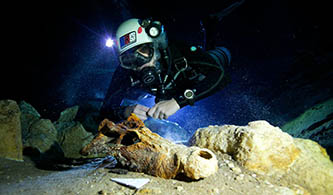Buried Treasure
Jan. 14, 2015

A diver searches for fossils in Madagascar.
National Science Foundation video on Prof. Rosenberger's lemur fossil discovery.
A research team led by Anthropology and Archaeology Professor Alfred Rosenberger recently discovered an undersea lemur graveyard, thought to be the largest collection of fossils representing the now extinct giant lemurs. The research was funded in part by the National Science Foundation and the National Geographic Society.
Working with University of Massachusetts Professor Emerita Laurie Godfrey and an international team of eight cave divers, Rosenberger and his team explored inland flooded caves off the west coast of Madagascar.
"This is the success of just phase one," says Rosenberger, adding that it was "the beginning of a complex international project that has a lot of long, hard work in store." The discovery of hundreds of ancient fossils makes it one of the most unique sites in the world.
The divers explored underwater caves in the Tsimanampesotse (pronounced sea-manam-pah-suits) National Park in central Madagascar, where they unearthed not only the lemurs, but also many other extinct species endemic to the island nation.
Over two days, Rosenberger’s team extracted the remains of numerous giant lemurs, elephant birds, horned crocodiles and extinct hippos, which had roamed the island hundreds or thousands of years ago. Thanks to the seclusion and protection of their underwater graves, many of the remains were intact and in good condition, which is a rare circumstance in mammal paleontology.
Rosenberger and his researchers hope this will become a multi-year project to further investigate the caves and evaluate their findings. Besides its potential importance for understanding the evolution of our primate relatives and other animals, it may foster a totally new era of fossil hunting that employs underwater paleontology, and it promises to shed new light on certain aspects of historic climate change, especially its role in extinction.
For more than 30 years, Rosenberger, an expert in evolutionary biology and anthropology, has studied nonhuman primates. His work has also taken him to South and Central America, where he has researched the behavior and ecology of monkeys in the forest and also their fossils.






